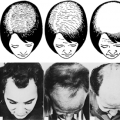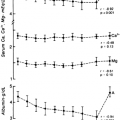CUSHING SYNDROME
David E. Schteingart
Cushing syndrome is the clinical expression of the metabolic effects of persistent, inappropriate hypercortisolism. Since the disorder was first described by Harvey Cushing in 1932, great progress has been made in understanding its pathophysiology and the spectrum of its clinical presentation. The diagnosis can now be precisely established by biochemical means, by noninvasive imaging of the pituitary and adrenal lesions, and by selective identification of the source of corticotropin (ACTH or adrenocorticotropic hormone) in the ACTH-dependent types.
The clinical manifestations of Cushing syndrome involve many organ systems and metabolic processes.1 Hypertension, obesity, diabetes, androgen-type hirsutism, and acne are commonly seen in these patients and are prevalent in patients who do not have primary cortisol excess. When present, the following findings increase the suspicion of Cushing syndrome: symptoms and signs of protein catabolism (e.g., ecchymoses, myopathy, osteopenia); truncal obesity; lanugal hirsutism; cutaneous lesions (i.e., wide, purple striae; tinea versicolor; verruca vulgaris); hyperpigmentation; and psychiatric manifestations (i.e., impairment of affect, cognition, and vegetative functions).2,3,4,5 and 6 In some instances, the diagnosis of Cushing syndrome can be strongly suspected on clinical grounds alone, but for most patients, the diagnosis is established by laboratory studies.7
Stay updated, free articles. Join our Telegram channel

Full access? Get Clinical Tree





